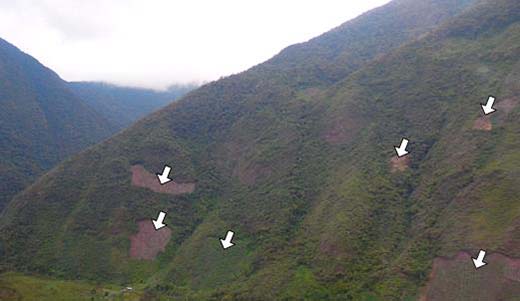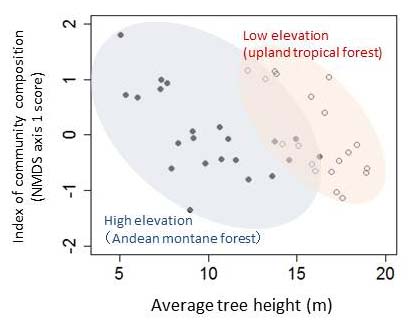Home > Research > Research Results > Research Results 2018 > Understanding tree community composition and tree height is key to assessing forest degradation in Andes
Update:November 30, 2018
Main content starts here.
Understanding tree community composition and tree height is key to assessing forest degradation in Andes
| Article title |
Variation in tree community composition and carbon stock under natural and human disturbances in Andean forests, Peru |
|---|---|
| Author (affiliation) |
Kazuki Miyamoto (a), Tamotsu Sato (a), Edgar Alexs Arana Olivos (b), Gabriel Clostre Orellana (b), Christian Marcel Rohner Stornaiuolo (b) (a) Department of Forest Vegetation, FFPRI, Tsukuba, Ibaraki, Japan. |
| Publication Journal |
Forests, 9(7):390, July 2018, DOI:10.3390/f9070390( External link ) |
| Content introduction |
In recent years, logging to convert land to agricultural use has been occurring in the forests of the Andes Mountains in South America. In addition, trees are being cut down for materials or firewood charcoal, and there are no large trees left in what remains of these forests. The types of trees also being reduced in number (this phenomenon is called “forest degradation”). This state of affairs is raising concern that functions of forests, such as maintaining carbon fixation and biodiversity, may decrease. Attempts are being made to evaluate the state of forests by ascertaining the composition of types of trees, also known as “tree community composition”. However, the Andes Mountains have a wide variety of trees at different elevations, along with varying interactions between people and nature, and this makes it difficult to discover how forest degradation is taking place. For this study, a survey was conducted of differences in tree community composition among forests at various elevations; from the upper tropical forests of the Cusco, Peru at 600 meters above sea level to Andes Mountain forests at 3,500 meters. In addition, visible remains of natural and artificial disturbances in and around these forests were also recorded. Survey results have demonstrated that tree community composition of forests from 2,400 meters to 3,500 meters showed the impact of artificial disturbances such as farming huts and walking paths, which made the tree community composition very different from forests with no such disturbances. Besides, the average height of forest trees reflected differences in tree community composition, and the average height of trees in forests at the same elevation was considered to decrease with progressive forest degradation. This study’s results, obtained through surveying various elevations, should be useful for evaluating forest degradation across wide areas—necessary when considering measures to protect the forests of the Andes Mountains. Note: Natural disturbances are, for instance, windthrow, landslides, erosion, and other naturally occurring phenomena that cause changes to forests. Artificial disturbances are human activities, including logging that cause changes in forests.
Figure: This chart reveals the relationship between the metric for tree community composition in forests (the NMDS 1 axis score) and average tree height. Tree community composition changes in line with average tree height in both upper tropical forests and the forests of the Andes Mountains.
|
Copyright © Forest Research and Management Organization. All rights reserved.


